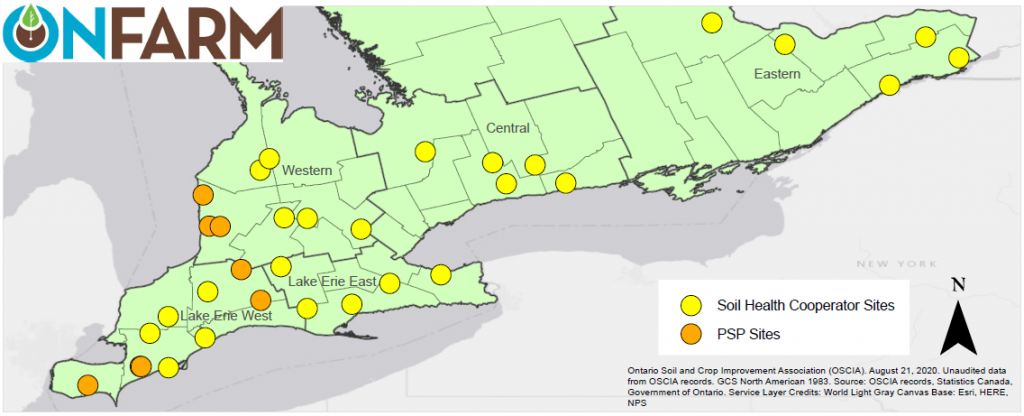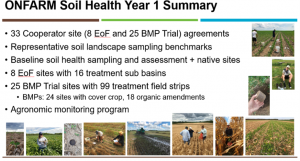Submitted by: OSCIA Provincial Office
On the heels of an exciting first year of on-farm soil health and water quality research, On-Farm Applied Research and Monitoring (ONFARM) cooperators across Ontario are seeing the benefits of that research. Ed Roodzant, cash crop farmer, OSCIA member, and ONFARM cooperator in Elgin County, is excited about the first year of the ONFARM program. Ed has farmed for 40 years in the Rodney area. He has practiced no-till and conservation tillage since the 1980s and Ed converted his fields to 100 percent strip-till in 2013. Ed has also used cover crops since 2015. Ed states, “I care about the land and believe these programs and good practices are very important.” He is a member of the Elgin Soil and Crop Improvement Association (SCIA) and plans to share results with members so others can benefit from this important research. The best management practice (BMP) research underway at Ed’s ONFARM site is coordinated by The Soil Resource Group (SRG) and studies the use of cover crops in a corn-soybean rotation and an organic amendment (biosolid pellets), and a combination of both in side-by-side strips. The field site is gently rolling on very fine sandy soils. Ed’s soil health goals are to maintain or improve soil organic matter levels with organic amendments and reduce compaction with cover crops.
Ed is one of 33 cooperators across five regions in the province: Lake Erie West, Lake Erie East, Western, Central, and Eastern. SRG reviewed more than 50 potential farm sites and assessed criteria that included predominant soil and landscape types across the province as well as crop rotation, tillage practices and farm attributes.
We asked Ed a series of questions about his experience with ONFARM, how it links up with Elgin SCIA activities and how soil health and BMP information can be better shared with Ontario’s agricultural community and beyond. Cathy Dibble, Thames Valley Regional Communications Coordinator (RCC), was also asked to provide background on the importance of connecting local SCIA members to valuable on-farm research like what Ed is doing through ONFARM. (Cathy’s responses are italicized):
What was your first year of participation in ONFARM like? Did anything change from the initial plan made with the researchers and were there any challenges?
ER: My first year with ONFARM was 2020, and there was no change from the initial plan. The only challenge was that it was hard to apply a consistent amount of biopellets to measure an accurate amount of product.
What are the soil health goals on your farm and how did they shape the plans you made with the ONFARM researchers?
ER: Soil health goals on my farm are to increase organic matter and fertility, increase worm populations using cover crops (rye) and adding organic amendments. The strategy is working well with the ONFARM researchers.
What aspects of ONFARM are interesting to Elgin SCIA members? What aspects do you think they want to learn about most?
ER: Members want to know if they can apply less fertilizer.
CD: Our members are always interested in learning what other producers are trying on their farms, and how different BMPs may affect production whether positively or negatively. Economic impact is always at the forefront, but improvements to soil health are important to producers as well.
What is the best way to share results from ONFARM with local SCIA members and the broader agricultural community?
ER: Share results in OSCIA’s newsletters.
CD: Local and regional associations are keen to organize events to promote on-farm research projects and results when possible, including plot tours and meetings, and also at larger learning events such as the Ontario Ag. Conference. Project reports and photos are also shared in OSCIA newsletters and on our websites.
How would you encourage Elgin SCIA members, and other farmers, to get involved in on-farm research?
ER: I would say for participants like myself to continue to speak personally to other farmers about the projects and benefits.
CD: By attending local and regional events and subscribing to OSCIA Grassroots Matters (our weekly e-blast), producers can keep abreast of opportunities to get involved in the many field projects that local associations plan each year.
What is one thing you would say to SCIA members before getting involved in a research trial?
ER: Be organized and committed.
CD: Producers should be sure to consider all the aspects and requirements before getting involved in field trials and be prepared for additional effort to follow all plot protocols.
Work is underway at all cooperator sites to verify and validate soil health indicators. Data analysis from each year of trials will determine multi-year crop and economic effects of selected BMPs. Cooperators and local SCIAs play a vital role in sharing information to help increase interest in, and adoption of, BMPs to enhance soil health and water quality in an economical way.
Furthermore, ONFARM will lay the groundwork for a long- term, viable network of demonstration farms to serve as outreach and education sites for Ontario’s agricultural industry.
OSCIA helps to share information about the great work its research partners and cooperators are doing via videos, factsheets, articles, and more. See how other cooperators are managing their ONFARM trials, soil health goals and farming sustainably for the future at: osciaresearch.org/ onfarm-applied-research/. Questions about ONFARM?
Please contact: onfarm@ontariosoilcrop.org. Follow OSCIA on Twitter (@OntarioSoilCrop) for updates on #ONFARM and all OSCIA programs.
The On-Farm Applied Research and Monitoring (ONFARM) program is a four-year, applied research initiative delivered by OSCIA on behalf of OMAFRA to support soil health and water quality research across farms in Ontario. This program is funded by the Canadian Agricultural Partnership, a federal- provincial-territorial initiative.


